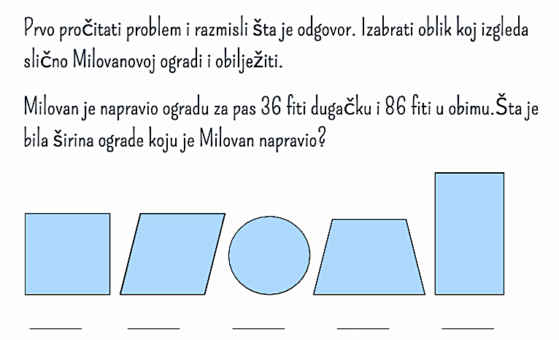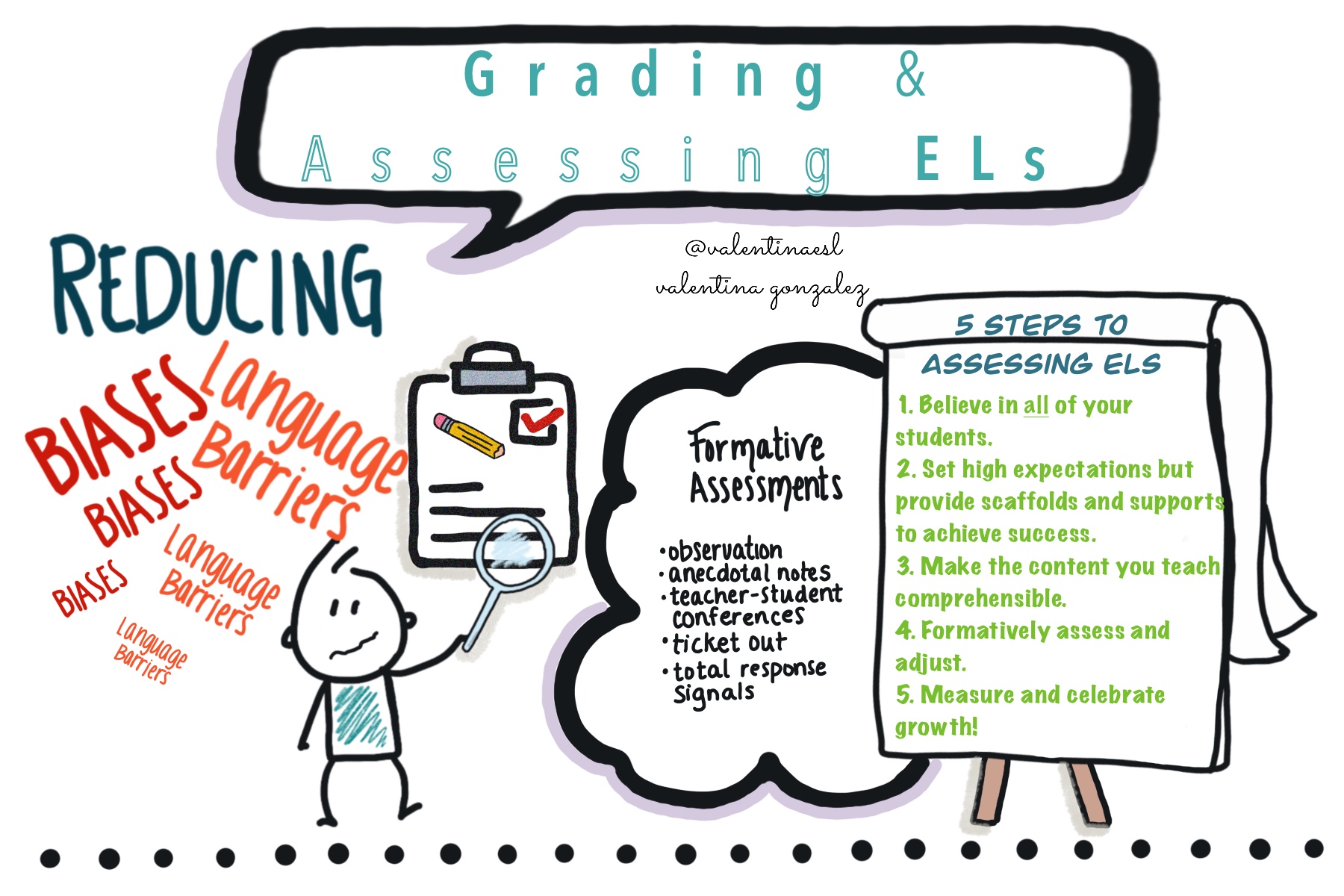How We Can Fairly Assess English Learners
A MiddleWeb Blog
 “ELLs are probably the most tested students in our educational system,” Wayne Wright (2015). Let that sink in. Yet one of the biggest challenges teachers of English learners face is effectively grading and assessing our students.
“ELLs are probably the most tested students in our educational system,” Wayne Wright (2015). Let that sink in. Yet one of the biggest challenges teachers of English learners face is effectively grading and assessing our students.
A primary goal of assessing is to find out what our students know and understand, but it can be difficult to find out what students know and understand if language is a barrier.
For example, if a student is at the beginner level of English proficiency, they may have trouble reading a multiple choice test to show what they know or understand regarding a topic. The reliability and validity of assessments may not be as true for English learners as they are for native English speakers.
A few years ago I served on a campus as an ESL specialist. During that time it was common for mainstream teachers to approach me for help and guidance with grading English learners in their classrooms.
It was clear that these teachers wanted the best for their students. They wanted to do right by them, however they recognized that something was off. They knew their students were cognitively capable of learning. The difficulty came when it was time to express mastery or show what they knew in English.
Here’s an Example to Think About
Think of yourself as a child in fourth grade. Here in America you were in advanced math classes. Now your family has moved to Serbia. You are given a placement test to help put you in the correct math class. Below is a sample question from the test. (FYI: You are not given technology to use for translation.)
How did you do? Were you able to determine the answer? What challenges did you face? What would support you?
Wright (2015) explains that a math test filled with word problems in English may not be a valid assessment of an ELs’ math ability. This type of assessment would become more of an assessment of the student’s English reading comprehension – much like the example above is more of an assessment of a student’s Serbian reading comprehension.
Breaking Through Biases & the Language Barrier
Grading and assessing ELs can be challenging for a multitude of reasons, two of which may be (1) biases within the assessments and (2) language barriers.
Biases
You may be thinking, “No, not my assessments. Mine are not biased.” That’s what I thought too. But taking a closer look, I realized that biases exist where we least expected them. Many assessments hold biases that we may not even be aware of at first glance.
Take for example, assessments that include stories or word problems about baseball. In America baseball is quite popular. However, for a newcomer from another country, this type of scenario could pose a challenge. Without the background knowledge of baseball and understanding the vocabulary, the student may get lost and confused within the text.

I’m not sure if there’s any way to prevent every bias, but we can definitely do a better job. Before the assessment, preview it with a lens for biases. When creating assessments, remain culturally responsive by representing students and their life experiences in the assessment. Create space in the assessment for students to share from their perspective.
Language Barriers
Sometimes English learners come to our classrooms not yet reading, speaking, and/or writing in English at grade level. They may be cognitively capable students. They can and will learn and achieve. But they are still acquiring English. The language barrier challenges us and them during assessment.
Remember the Serbian math example from above? The language barrier there may have kept you from accessing the question. The question does not validly assess your mathematical capability. However, it may assess your Serbian reading comprehension.
Reducing the language barrier when assessing students will vary depending on each students’ language proficiency level in English and the literacy they have in their primary language. Providing students with opportunities to draw answers instead of writing, responding in their primary language, verbal responses, and translation support are a few ways to reduce the language barrier.
Don’t Wait….

Formative assessments help us to mind the gap. Minding the gap in educational terms means that we recognize where students are individually (what they come to the table with) and where we need to take them. The gap is the space between the two. We must mind it, being cognizant that the gap exists and intentionally planning strategic steps towards the goal.
Formative assessments are classroom-based checkpoints that guide and “FORM” instruction. They are not tests or grades per se. But they are ways for the teacher to find out what students know and don’t know in order to create instruction to meet their needs.
Examples:
- Observation and anecdotal notes
- Reading and writing conferences
- Ticket out
- Total Response Signals (7 Steps to a Language Rich Interactive Classroom has a great chapter on this.)
- White board responses
- Thumbs up/down
- Yes/No cards or True/False cards
Why are formative assessments effective?
Formative assessments help us to close gaps in instruction before they grow too large. If we fail to formatively assess, we won’t notice gaps that form and misconceptions that students have. Then when it does come time to summatively assess or take a grade, it is too late. Students have cemented learning. Fenner and Snyder (2017) write that “the ultimate benefit of using formative assessment for ELs is that it provides teachers with ongoing insights into students’ learning…”
In the book Breaking Down the Wall (2020) Gottlieb, Honigsfeld and their colleagues push us to think about moving toward assessment for learning rather than assessment of learning. This means that assessments are more student centered and part of instruction.
What can we do?
Building on students’ assets and creating risk-free, happy classrooms will certainly help English learners and all students do better than if we do the opposite. Importantly, we must make the content we teach comprehensible. Period.
What we deliver, whether it is through lecture or through reading, needs to be understandable to each student that receives the information. If students do not understand what they hear or read, what is taught, then when we assess, we have set them up for failure.
To make content comprehensible (understandable), we can accommodate with chunking the lesson, using visuals, providing adapted texts, offering sentence stems and word banks, allowing wait time and structured opportunities to have academic conversations with peers, etc. The five steps below can help you think about your next steps in assessing ELs.
- Believe in all of your students.
- Set high expectations but provide scaffolds and supports to achieve success.
- Make the content you teach comprehensible.
- Formatively assess and adjust.
- Measure and celebrate growth!
Two amazing authors and teachers, Larry Ferlazzo and Katie Hull Sypieski, share their views on grading in this article, Grading English Language Learners: A Perspective From Two Teachers, I love how they view grades as information. “(Grades) are one of the many forms of communication we use with students and their parents, and definitely not the most important kind.” In the article they also share their grading guidelines.
I think many educators will agree that grading and assessing ELs is not easy. But if we keep in mind that not everyone has to produce the same product or learn the same way to show mastery, we will increase student success and achievement
In the end, it’s important not to put too much emphasis on a single exam or assessment but rather to look at a child’s overall learning progression – much like we would not like to be judged based on a single snapshot of ourselves. I’m reminded of the powerful video called The Testing Camera from children’s book author Peter Reynolds. I encourage you to watch if you have 4 minutes.
Please share your thoughts and experiences with grading and assessing English learners with us in the comments below.
References
Calderón Margarita. Breaking down the Wall: Essential Shifts for English Learners Success. Corwin, 2020.
Grading English Language Learners – A Perspective From Two Teachers. (2018, February 20). Retrieved from https://larryferlazzo.edublogs.org/2018/02/20/grading-english-language-learners-a-perspective-from-two-teachers/
Fenner, D. S., Kester, J., & Snyder, S. (2019, April 16). The Five Pillars of Equitably Grading ELLs. Retrieved from https://www.colorincolorado.org/blog/five-pillars-equitably-grading-ells
Seidlitz, J., & Perryman, B. (2011). 7 Steps to a language-rich interactive classroom: research-based strategies for engaging all students. San Clemente, CA: Seidlitz Education.
Wright, W. E. (2015). Foundations for teaching English language learners: research, theory, policy, and practice. Philadelphia, PA: Caslon, Inc.





































